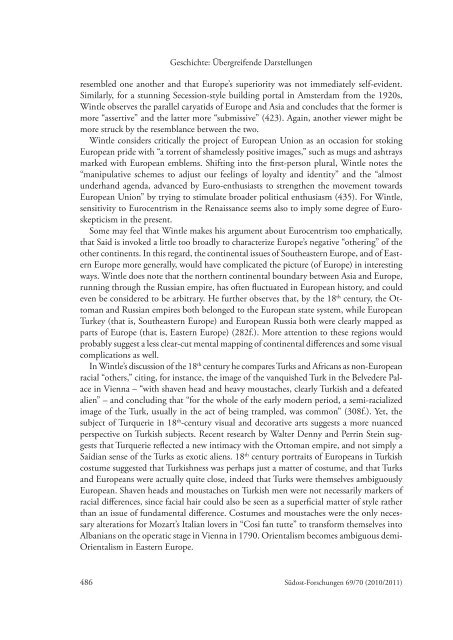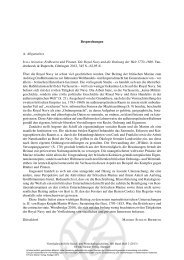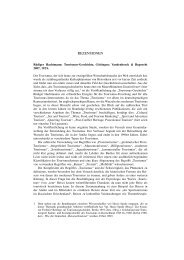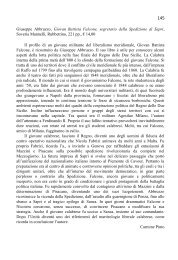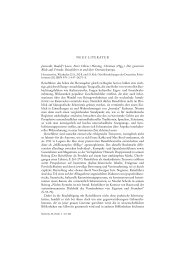69/70 (2010/2011) - Recensio.net
69/70 (2010/2011) - Recensio.net
69/70 (2010/2011) - Recensio.net
Sie wollen auch ein ePaper? Erhöhen Sie die Reichweite Ihrer Titel.
YUMPU macht aus Druck-PDFs automatisch weboptimierte ePaper, die Google liebt.
Geschichte: Übergreifende Darstellungen<br />
resembled one another and that Europe’s superiority was not immediately self-evident.<br />
Similarly, for a stunning Secession-style building portal in Amsterdam from the 1920s,<br />
Wintle observes the parallel caryatids of Europe and Asia and concludes that the former is<br />
more “assertive” and the latter more “submissive” (423). Again, another viewer might be<br />
more struck by the resemblance between the two.<br />
Wintle considers critically the project of European Union as an occasion for stoking<br />
European pride with “a torrent of shamelessly positive images,” such as mugs and ashtrays<br />
marked with European emblems. Shifting into the first-person plural, Wintle notes the<br />
“manipulative schemes to adjust our feelings of loyalty and identity” and the “almost<br />
underhand agenda, advanced by Euro-enthusiasts to strengthen the movement towards<br />
European Union” by trying to stimulate broader political enthusiasm (435). For Wintle,<br />
sensitivity to Eurocentrism in the Renaissance seems also to imply some degree of Euroskepticism<br />
in the present.<br />
Some may feel that Wintle makes his argument about Eurocentrism too emphatically,<br />
that Said is invoked a little too broadly to characterize Europe’s negative “othering” of the<br />
other continents. In this regard, the continental issues of Southeastern Europe, and of Eastern<br />
Europe more generally, would have complicated the picture (of Europe) in interesting<br />
ways. Wintle does note that the northern continental boundary between Asia and Europe,<br />
running through the Russian empire, has often fluctuated in European history, and could<br />
even be considered to be arbitrary. He further observes that, by the 18 th century, the Ottoman<br />
and Russian empires both belonged to the European state system, while European<br />
Turkey (that is, Southeastern Europe) and European Russia both were clearly mapped as<br />
parts of Europe (that is, Eastern Europe) (282f.). More attention to these regions would<br />
probably suggest a less clear-cut mental mapping of continental differences and some visual<br />
complications as well.<br />
In Wintle’s discussion of the 18 th century he compares Turks and Africans as non-European<br />
racial “others,” citing, for instance, the image of the vanquished Turk in the Belvedere Palace<br />
in Vienna – “with shaven head and heavy moustaches, clearly Turkish and a defeated<br />
alien” – and concluding that “for the whole of the early modern period, a semi-racialized<br />
image of the Turk, usually in the act of being trampled, was common” (308f.). Yet, the<br />
subject of Turquerie in 18 th -century visual and decorative arts suggests a more nuanced<br />
perspective on Turkish subjects. Recent research by Walter Denny and Perrin Stein suggests<br />
that Turquerie reflected a new intimacy with the Ottoman empire, and not simply a<br />
Saidian sense of the Turks as exotic aliens. 18 th century portraits of Europeans in Turkish<br />
costume suggested that Turkishness was perhaps just a matter of costume, and that Turks<br />
and Europeans were actually quite close, indeed that Turks were themselves ambiguously<br />
European. Shaven heads and moustaches on Turkish men were not necessarily markers of<br />
racial differences, since facial hair could also be seen as a superficial matter of style rather<br />
than an issue of fundamental difference. Costumes and moustaches were the only necessary<br />
alterations for Mozart’s Italian lovers in “Cosi fan tutte” to transform themselves into<br />
Albanians on the operatic stage in Vienna in 1790. Orientalism becomes ambiguous demi-<br />
Orientalism in Eastern Europe.<br />
486 Südost-Forschungen <strong>69</strong>/<strong>70</strong> (<strong>2010</strong>/<strong>2011</strong>)


